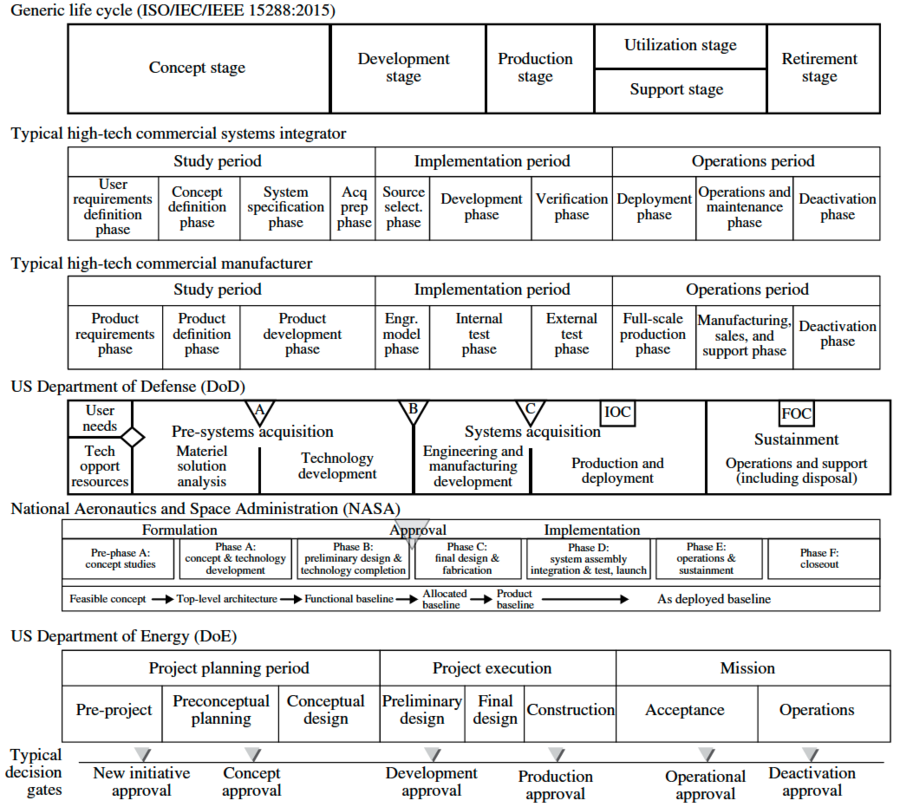Life Cycle Models
A life cycle is the evolution of a system, product, service, project or other human-made entity from conception through retirement. It can be helpful to create models to depict and manage the progression of an entity from beginning to end. These models are called life cycle models.
Life Cycle Models
It can be helpful to create models to depict and manage the progression of an entity from beginning to end. These models are called life cycle models. A life cycle model is a framework of processes and activities concerned with the life cycle which can be organized into stages, acting as a common reference for communication and understanding [SOURCE: ISO/IEC/IEEE 24748-1:2024]
Movement between stages represents a decision point with specific criteria related to stage entry and exit. See Article – Life Cycle Stages for more information. Life cycle models provide a decision-linked segmentation of the conceptualization, development, production, utilization, support, and retirement of the system and its elements.
Any system of interest can be regarded from the perspective of one or more life cycle models. Some life cycle models permit iteration and concurrency of stages while some do not. Which stage(s) a system of interest is in depends on the life cycle model. A system of interest can be in multiple life cycle stages at the same time.
Four common principles associated with a life cycle model are the following:
- a system progresses through specific stages during its life;
- enabling systems should be available for each stage to achieve the outcomes of the stage;
- at specific life cycle stages, quality characteristics such as producibility, usability, supportability and disposability should be specified and designed or implemented into a system;
- stages begin and end based on criteria or external events.
Figure 1 shows models with stage names depending on the context. However, note that some of the models are project models, not life cycle models. That is, they model the phases of a project, not the stages of the life cycle of a system.
Example
Depending on the life cycle model, stages can occur in parallel and multiple times. Progression through the stages of a life cycle can be depicted in many ways. In Figure 2, the concept stage is short, development and production are longer, while utilization, support, and retirement are lengthy.
In this model for a system of interest where multiple units were produced, utilization and support stages began with the first unit. For the software element, support began during early development, well before delivery to operations. Retirement began when the first unit retired or was lost to damage. In this example the development approach envisioned a mid-life upgrade, so the concept, development and production stages were restarted. Consequently, the support stage ran parallel to utilization until the last unit was removed from service. Support ended while units were still being utilized. The retirement stage continued until the last unit was retired. It is not always possible for the initial developer to know if units are still being utilized.
Many life cycle models depict the stages as left to right. DevOps (and DevSecOps) includes a life cycle model that depicts the life cycle stages in an infinity loop as shown in Figure 3. In this model, there is no distinction between development and support; that is, the work is never “done”. The model also assumes that the risks and effort associated with retirement are negligible, and thus it does not need to be a focus of the model.
Life Cycle Processes
The processes and activities that are integrated into the framework of a life cycle model are often referred to as life cycle processes. They can be seen as one of the enablers to help manage a system solution across the life cycle stages. In some life cycle models the life cycle processes can be applied concurrently, iteratively, and recursively with other enablers (e.g., tools, technology) throughout the stages of the life cycle.
ISO/IEC/IEEE 15288, SAE 1001 and INCOSE SE Handbook define system life cycle processes. In SEBoK, these life cycle processes can be found in KAs Technical Management Processes, System Concept Definition, System Architecture Design Definition, and System Maintenance.
In most cases, organization-specific processes are defined for the life cycle phases in which an organization is usually heavily involved in projects. Organizations that develop systems “from scratch”, often have detailed processes to navigate the SoI through the stages Concept and Development. In case the manufacturing of the SoI is outsourced, the implementation process is rather thin (it cannot be removed as this process is invoked to identify constraints on the SoI related to implementation) and when the organization manufactures the SoI, the implementation process is more detailed.
References
Works Cited
INCOSE. 2023. "Chapter 2.1.2" in Systems Engineering Handbook: A Guide for System Life Cycle Processes and Activities, 5th Edition. Ed(s): D. Walden, T.M. Shortell, G.J. Roedler, B.A. Delicado, O. Mornas, Y. Yew-Seng, D. Endler. San Diego, CA: International Council on Systems Engineering (INCOSE). Available at https://www.incose.org/publications/se-handbook-v5.
ISO/IEC/IEEE 15288. 2023. Systems and software engineering — System life cycle processes. Geneva, Switzerland: International Organization for Standardization (ISO), International Electrotechnical Commission, and Institute of Electrical and Electronics Engineers. Available at https://www.iso.org/standard/81702.html.
ISO/IEC/IEEE 24748-1. 2024. Systems and software engineering — Life cycle management, Part 1: Guidelines for life cycle management. Geneva, Switzerland: International Organization for Standardization (ISO), International Electrotechnical Commission, and Institute of Electrical and Electronics Engineers. Available at https://www.iso.org/standard/84709.html.
Primary References
None.
Additional References
None.


